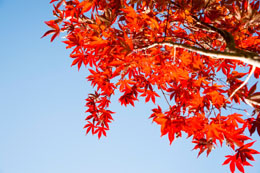If you are looking for tips on pruning Japanese maple trees, you have landed on the right page. Read to get information about the method and best time to prune them.

Pruning is an essential part of gardening. In fact, some gardeners have taken pruning to the level of an art. Each plant is different, with its own growth rate and pattern. That is why, every tree requires a specialized pruning plan, just like we need a specialized haircut.
About Japanese Maple Trees
The Japanese maple, originally known as
Irohamomiji in Japanese, is a woody plant, which is native to the Orient and is mainly found in Japan, Korea, and China. There are many cultivars of this type of maple and they are found throughout the world.
Particularly sought after, due to their elegance and aesthetic appeal, these plants require periodic pruning. When this species was first brought to Europe, it was named as '
Acer Palmatum' due to the hand shaped leaves it has.
Even the original Japanese name (Irohamomiji) refers to the leaf shape, which resembles baby hands. Their dome-shaped growth pattern, beautiful branching pattern, and rich colors, make them a popular choice in gardens. Even bonsai Japanese maples are available, which are grown as indoor potted plants.
When to Prune Them
There is a time to sow, time to reap, and also a time to prune trees, if you want them to conform to a specific growth pattern. You may prune Japanese maple in late summer or in the period between late fall and early winter.
The choice of the latter period makes pruning easier for beginners, as the trees are leafless then and their branching pattern is more discernible. Having a look at the bones of the tree, which are the branches, you can decide how to alter its structure through pruning. Lightly pruning the trees is possible in any season. The only time when it is not advisable is during spring, when the trees have sap rising in them.
Besides knowing when to prune them, you need to know what exactly should you prune. It is meant to promote the growth of the tree and make it presentable. The parts of the tree, that you must get rid of, through pruning are dead or deformed branches, crossing branches, and branches growing in wrong directions. Of course, which direction is wrong, will be decided by the pattern you want the tree to grow into.
Tips on Pruning
There are many varieties of Japanese maple trees and each one of them requires a different type of pruning. The tools you'll need for the job are pruning shears, along with bleach, and pruning sealant. Even if you are thinking of pruning dwarf or weeping Japanese maples, these tips will come in handy, as they are quite generalized. Here are some tips.
Plan Out the Look
Decide the kind of look that you want the tree to have. Plan your pruning accordingly. Some people prune these trees, over a period of three years, which ensures that their natural growth is not hampered. Prune only a few branches at a time. Pruning sickly or dead branches should not be delayed. A bottom-up and inside-out pruning pattern is advised.
Clean and Sharpen Pruning Tools
The pruning shears should be washed in bleach or sterilized if possible, to prevent contagion of plant diseases. Also, make sure that the tool is sharp enough and if it's blunt, sharpen it. This will ensure that you make a clean cut and don't need to twist a branch off.
Do Not Prune More Than One-Third
Another thing to remember is regarding the extent of pruning you can have at one go. It is advised by expert gardeners that not more than one-third of the tree should be pruned, at a time.
Seal Pruning Cuts
Make sure that you seal the pruning cuts after the job is done. This prevents bleeding of sap and insect infestation. Plan periodic checks of the tree for any signs of bleeding cuts. Make sure that they are sealed properly.
Pruning these trees is all about the right technique and timing. It aids growth and enhances its aesthetic appeal.






 Pruning is an essential part of gardening. In fact, some gardeners have taken pruning to the level of an art. Each plant is different, with its own growth rate and pattern. That is why, every tree requires a specialized pruning plan, just like we need a specialized haircut.
Pruning is an essential part of gardening. In fact, some gardeners have taken pruning to the level of an art. Each plant is different, with its own growth rate and pattern. That is why, every tree requires a specialized pruning plan, just like we need a specialized haircut.